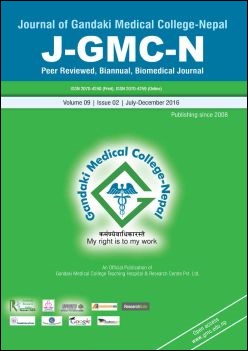Liver Abscess: An Institutional Review at Gandaki Medical College Teaching Hospital
DOI:
https://doi.org/10.3126/jgmcn.v9i2.17859Keywords:
Liver abscess, Percutaneous drainage, PyogenicAbstract
Background: Although liver abscess is a potentially life threatening disease, early diagnosis and prompt treatment has resulted good clinical outcome. The epidemiology and management of this condition have evolved over time.
Objective: To study our experience in clinical characteristics and management of liver abscess in a tertiary hospital over a period of three years.
Methods: The hospital records of all patients discharged with the diagnosis of liver abscess from September 2010 to March 2013 were reviewed. The demographics, clinical presentation, investigation tools, method of treatment and outcome were recorded and analyzed.
Results: Total of 17 patients of liver abscess were admitted during this period, of which, 13 were pyogenic and four amebic. The median age was 50 (7 - 75) years with male to female ratio of 1.42 : 1. Age group 40 - 60 years was most commonly affected. Single lesions were found in 11 (64.7%) and multiple in six (35.3%) patients. The most common presentation was fever and abdominal pain/tenderness. Jaundice was seen in five (29.4%) patients and abnormal liver function test in 10 (58.8%) patients. Commonest route of infection among pyogenic liver abscess were through biliary tree pathology (Five patients) and via portal venous system (Three patients). Pus and blood culture were positive in six (46.15%) and four (30.76%) patients respectively, and E. coli was the commonest pathogen isolated. Patients were treated with anti-microbial therapy and interventional radiology techniques: Nine patients with percutaneous needle aspiration, four with percutaneous drainage. Antibiotics alone were sufficient in three patients and open surgical drainage was required in one patient. There was one case of mortality where the abscess was associated with diabetes mellitus.
Conclusion: Liver abscess is a potentially life threatening disease and commonly associated with underlying gastrointestinal pathology. Adequate antibiotic coverage and image guided intervention is optimal first-line treatment with favorable outcome.
Journal of Gandaki Medical College
Volume, 09, Number 2, July December 2016, Page: 7-12
Downloads
Downloads
Published
How to Cite
Issue
Section
License
This license allows reusers to distribute, remix, adapt, and build upon the material in any medium or format for noncommercial purposes only, and only so long as attribution is given to the creator.

